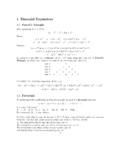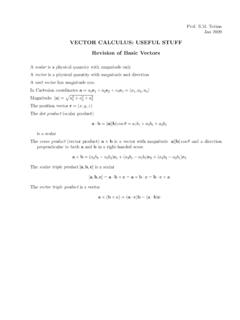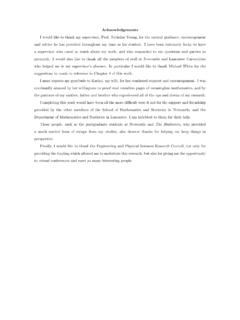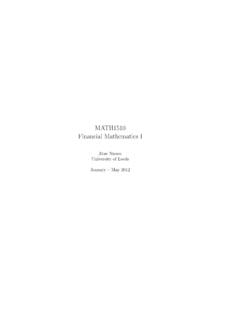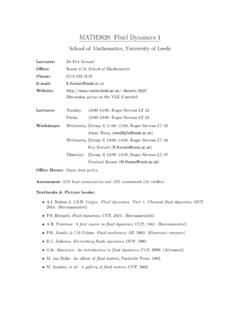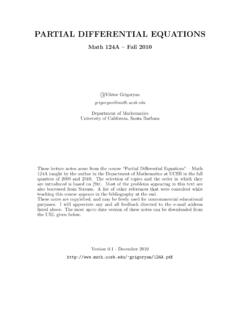Transcription of Analytic Solutions of Partial Di erential Equations
1 Analytic Solutions of Partial Differential Equations MATH3414. School of Mathematics, University of Leeds 15 credits Taught Semester 1, Year running 2003/04. Pre-requisites MATH2360 or MATH2420 or equivalent. Co-requisites None. Objectives: To provide an understanding of, and methods of solution for, the most important types of Partial differential Equations that arise in Mathematical Physics. On completion of this module, students should be able to: a) use the method of characteristics to solve first- order hyperbolic Equations ; b) classify a second order PDE as elliptic, parabolic or hyperbolic; c) use Green's functions to solve elliptic Equations ; d) have a basic understanding of diffusion; e) obtain a priori bounds for reaction-diffusion Equations . Syllabus: The majority of physical phenomena can be described by Partial differential equa- tions ( the Navier-Stokes equation of fluid dynamics, Maxwell's Equations of electro- magnetism).
2 This module considers the properties of, and analytical methods of solution for some of the most common first and second order PDEs of Mathematical Physics. In particu- lar, we shall look in detail at elliptic Equations (Laplace?s equation), describing steady-state phenomena and the diffusion / heat conduction equation describing the slow spread of con- centration or heat. The topics covered are: First order PDEs. Semilinear and quasilinear PDEs; method of characteristics. Characteristics crossing. Second order PDEs. Classifi- cation and standard forms. Elliptic Equations : weak and strong minimum and maximum principles; Green's functions. Parabolic Equations : exemplified by Solutions of the diffusion equation. Bounds on Solutions of reaction-diffusion Equations . Form of teaching Lectures: 26 hours. 7 examples classes. Form of assessment One 3 hour examination at end of semester (100%). ii Details: Evy Kersale.
3 Office: Phone: 0113 343 5149. E-mail: WWW: kersale/. Schedule: three lectures every week, for eleven weeks (from 27/09 to 10/12). Tuesday 13:00 14:00 RSLT 03. Wednesday 10:00 11:00 RSLT 04. Friday 11:00 12:00 RSLT 06. Pre-requisite: elementary differential calculus and several variables calculus ( Partial differentiation with change of variables, parametric curves, integration), elementary alge- bra ( Partial fractions, linear eigenvalue problems), ordinary differential Equations ( change of variable, integrating factor), and vector calculus ( vector identities, Green's theorem). Outline of course: Introduction: definitions examples First order PDEs: linear & semilinear characteristics quasilinear nonlinear system of Equations Second order linear PDEs: classification elliptic parabolic Book list: P. Prasad & R. Ravindran, Partial Differential Equations , Wiley Eastern, 1985. W. E. Williams, Partial Differential Equations , Oxford University Press, 1980.
4 P. R. Garabedian, Partial Differential Equations , Wiley, 1964. Thanks to Prof. D. W. Hughes, Prof. J. H. Merkin and Dr. R. Sturman for their lecture notes. Course Summary Definitions of different type of PDE ( linear , quasilinear, semilinear, nonlinear). Existence and uniqueness of Solutions Solving PDEs analytically is generally based on finding a change of variable to transform the equation into something soluble or on finding an integral form of the solution. First order PDEs u u a +b = c. x y linear Equations : change coordinate using (x, y), defined by the characteristic equation dy b = , dx a and (x, y) independent (usually = x) to transform the PDE into an ODE. Quasilinear Equations : change coordinate using the Solutions of dx dy du = a, =b and =c ds ds ds to get an implicit form of the solution (x, y, u) = F ( (x, y, u)). Nonlinear waves: region of solution. System of linear Equations : linear algebra to decouple Equations .
5 Second order PDEs 2u 2u 2u u u a 2. + 2b + c 2. +d +e + f u = g. x x y y x y iii iv Classification Type Canonical form Characteristics p b2 ac > 0 Hyperbolic 2u + .. = 0 dy = b b2 ac dx a b2 ac = 0 Parabolic 2u + .. = 0 dy = ab , = x (say). 2 dx p . b2 ac < 0 Elliptic 2u + 2u + .. = 0 dy = b b2 ac , = + . 2 2 dx a = i( ). Elliptic Equations : (Laplace equation.) Maximum Principle. Solutions using Green's functions (uses new variables and the Dirac -function to pick out the solution). Method of images. Parabolic Equations : (heat conduction, diffusion equation.) Derive a fundamental so- lution in integral form or make use of the similarity properties of the equation to find the solution in terms of the diffusion variable x = . 2 t First and Second Maximum Principles and Comparison Theorem give bounds on the solution, and can then construct invariant sets. Contents 1 Introduction 1. Motivation .. 1. Reminder.
6 1. Definitions .. 2. Examples .. 3. Wave Equations .. 3. Diffusion or Heat Conduction Equations .. 4. Laplace's Equation .. 4. Other Common Second order linear PDEs .. 4. Nonlinear PDEs .. 5. System of PDEs .. 5. Existence and Uniqueness .. 6. 2 First order Equations 9. linear and Semilinear Equations .. 9. Method of Characteristic .. 9. Equivalent set of ODEs .. 12. Characteristic Curves .. 14. Quasilinear Equations .. 19. Interpretation of Quasilinear Equation .. 19. General solution: .. 20. Wave Equation .. 26. linear Waves .. 26. Nonlinear Waves .. 27. Weak Solution .. 29. Systems of Equations .. 31. linear and Semilinear Equations .. 31. Quasilinear Equations .. 34. 3 Second order linear and Semilinear Equations in Two Variables 37. Classification and Standard Form Reduction .. 37. Extensions of the Theory .. 44. linear second order Equations in n variables .. 44. The Cauchy Problem .. 45. i ii CONTENTS.
7 4 Elliptic Equations 49. Definitions .. 49. Properties of Laplace's and Poisson's Equations .. 50. Mean Value Property .. 51. Maximum-Minimum Principle .. 52. Solving Poisson Equation Using Green's Functions .. 54. Definition of Green's Functions .. 55. Green's function for Laplace Operator .. 55. Free Space Green's Function .. 60. Method of Images .. 61. Extensions of Theory: .. 68. 5 Parabolic Equations 69. Definitions and Properties .. 69. Well-Posed Cauchy Problem (Initial Value Problem) .. 69. Well-Posed Initial-Boundary Value Problem .. 70. Time Irreversibility of the Heat Equation .. 70. Uniqueness of Solution for Cauchy Problem: .. 71. Uniqueness of Solution for Initial-Boundary Value Problem: .. 71. Fundamental Solution of the Heat Equation .. 72. Integral Form of the General Solution .. 73. Properties of the Fundamental Solution .. 74. Behaviour at large t .. 75. Similarity Solution .. 75. Infinite Region.
8 76. Semi-Infinite Region .. 77. Maximum Principles and Comparison Theorems .. 78. First Maximum Principle .. 79. 2. A Integral of e x in R 81. Chapter 1. Introduction Contents Motivation .. 1. Reminder .. 1. Definitions .. 2. Examples .. 3. Existence and Uniqueness .. 6. Motivation Why do we study Partial differential Equations (PDEs) and in particular Analytic Solutions ? We are interested in PDEs because most of mathematical physics is described by such equa- tions. For example, fluids dynamics (and more generally continuous media dynamics), elec- tromagnetic theory, quantum mechanics, traffic flow. Typically, a given PDE will only be accessible to numerical solution (with one obvious exception exam questions!) and ana- lytic Solutions in a practical or research scenario are often impossible. However, it is vital to understand the general theory in order to conduct a sensible investigation. For example, we may need to understand what type of PDE we have to ensure the numerical solution is valid.
9 Indeed, certain types of Equations need appropriate boundary conditions; without a knowledge of the general theory it is possible that the problem may be ill-posed of that the method is solution is erroneous. Reminder Partial derivatives: The differential (or differential form) of a function f of n independent variables, (x1 , x2 , .. , xn ), is a linear combination of the basis form (dx 1 , dx2 , .. , dxn ). n X f f f f df = dxi = dx1 + dx2 + .. + dxn , xi x1 x2 xn i=1. where the Partial derivatives are defined by f f (x1 , x2 , .. , xi + h, .. , xn ) f (x1 , x2 , .. , xi , .. , xn ). = lim . xi h 0 h 1. 2 Definitions The usual differentiation identities apply to the Partial differentiations (sum, product, quo- tient, chain rules, etc.). Notations: I shall use interchangeably the notations f 2f xi f f xi , x2i xj f fxi xj , xi xi xj for the first order and second order Partial derivatives respectively.
10 We shall also use inter- changeably the notations ~u u u, for vectors. Vector differential operators: in three dimensional Cartesian coordinate system (i, j, k). we consider f (x, y, z) : R3 R and [ux (x, y, z), uy (x, y, z), uz (x, y, z)] : R3 R3 . Gradient: f = x f i + y f j + z f k. Divergence: div u u = x ux + y uy + z uz. Curl: u = ( z uy y uz ) i + ( z ux x uz ) j + ( x uy y ux ) k. Laplacian: f 2 f = x2 f + y2 f + z2 f. Laplacian of a vector: u 2 u = 2 ux i + 2 uy j + 2 uz k. Note that these operators are different in other systems of coordinate (cylindrical or spherical, say). Definitions A Partial differential equation (PDE) is an equation for some quantity u (dependent variable). which depends on the independent variables x 1 , x2 , x3 , .. , xn , n 2, and involves derivatives of u with respect to at least some of the independent variables. F (x1 , .. , xn , x1 u, .. , xn u, x21 u, x21 x2 u.)

